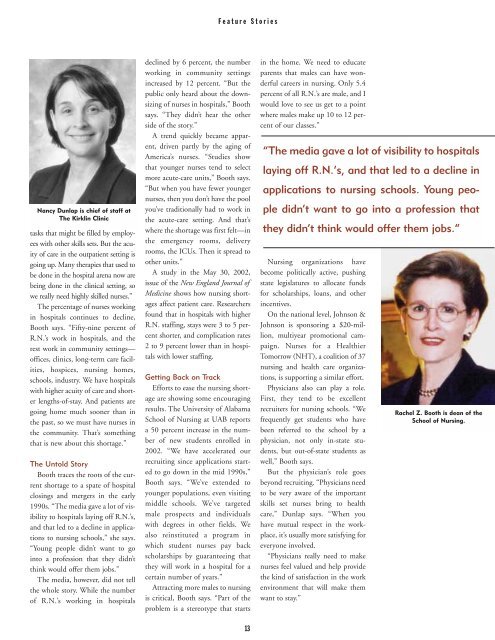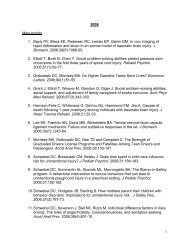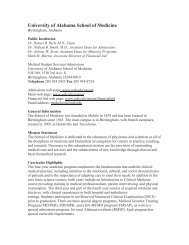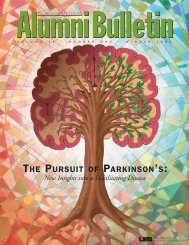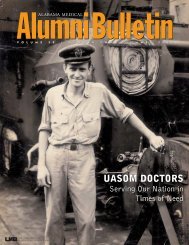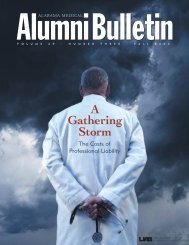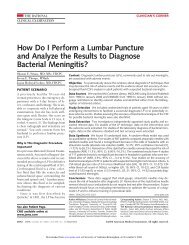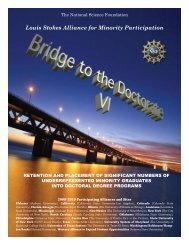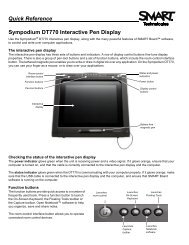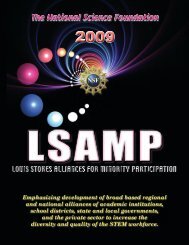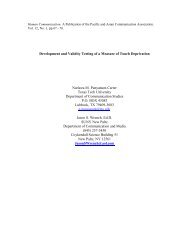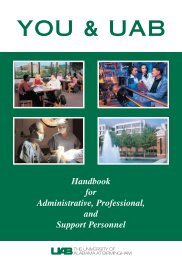AlumniBulletin - University of Alabama at Birmingham
AlumniBulletin - University of Alabama at Birmingham
AlumniBulletin - University of Alabama at Birmingham
You also want an ePaper? Increase the reach of your titles
YUMPU automatically turns print PDFs into web optimized ePapers that Google loves.
Fe<strong>at</strong>ure Stories<br />
Nancy Dunlap is chief <strong>of</strong> staff <strong>at</strong><br />
The Kirklin Clinic<br />
tasks th<strong>at</strong> might be filled by employees<br />
with other skills sets. But the acuity<br />
<strong>of</strong> care in the outp<strong>at</strong>ient setting is<br />
going up. Many therapies th<strong>at</strong> used to<br />
be done in the hospital arena now are<br />
being done in the clinical setting, so<br />
we really need highly skilled nurses.”<br />
The percentage <strong>of</strong> nurses working<br />
in hospitals continues to decline,<br />
Booth says. “Fifty-nine percent <strong>of</strong><br />
R.N.’s work in hospitals, and the<br />
rest work in community settings—<br />
<strong>of</strong>fices, clinics, long-term care facilities,<br />
hospices, nursing homes,<br />
schools, industry. We have hospitals<br />
with higher acuity <strong>of</strong> care and shorter<br />
lengths-<strong>of</strong>-stay. And p<strong>at</strong>ients are<br />
going home much sooner than in<br />
the past, so we must have nurses in<br />
the community. Th<strong>at</strong>’s something<br />
th<strong>at</strong> is new about this shortage.”<br />
The Untold Story<br />
Booth traces the roots <strong>of</strong> the current<br />
shortage to a sp<strong>at</strong>e <strong>of</strong> hospital<br />
closings and mergers in the early<br />
1990s. “The media gave a lot <strong>of</strong> visibility<br />
to hospitals laying <strong>of</strong>f R.N.’s,<br />
and th<strong>at</strong> led to a decline in applic<strong>at</strong>ions<br />
to nursing schools,” she says.<br />
“Young people didn’t want to go<br />
into a pr<strong>of</strong>ession th<strong>at</strong> they didn’t<br />
think would <strong>of</strong>fer them jobs.”<br />
The media, however, did not tell<br />
the whole story. While the number<br />
<strong>of</strong> R.N.’s working in hospitals<br />
declined by 6 percent, the number<br />
working in community settings<br />
increased by 12 percent. “But the<br />
public only heard about the downsizing<br />
<strong>of</strong> nurses in hospitals,” Booth<br />
says. “They didn’t hear the other<br />
side <strong>of</strong> the story.”<br />
A trend quickly became apparent,<br />
driven partly by the aging <strong>of</strong><br />
America’s nurses. “Studies show<br />
th<strong>at</strong> younger nurses tend to select<br />
more acute-care units,” Booth says.<br />
“But when you have fewer younger<br />
nurses, then you don’t have the pool<br />
you’ve traditionally had to work in<br />
the acute-care setting. And th<strong>at</strong>’s<br />
where the shortage was first felt—in<br />
the emergency rooms, delivery<br />
rooms, the ICUs. Then it spread to<br />
other units.”<br />
A study in the May 30, 2002,<br />
issue <strong>of</strong> the New England Journal <strong>of</strong><br />
Medicine shows how nursing shortages<br />
affect p<strong>at</strong>ient care. Researchers<br />
found th<strong>at</strong> in hospitals with higher<br />
R.N. staffing, stays were 3 to 5 percent<br />
shorter, and complic<strong>at</strong>ion r<strong>at</strong>es<br />
2 to 9 percent lower than in hospitals<br />
with lower staffing.<br />
Getting Back on Track<br />
Efforts to ease the nursing shortage<br />
are showing some encouraging<br />
results. The <strong>University</strong> <strong>of</strong> <strong>Alabama</strong><br />
School <strong>of</strong> Nursing <strong>at</strong> UAB reports<br />
a 50 percent increase in the number<br />
<strong>of</strong> new students enrolled in<br />
2002. “We have acceler<strong>at</strong>ed our<br />
recruiting since applic<strong>at</strong>ions started<br />
to go down in the mid 1990s,”<br />
Booth says. “We’ve extended to<br />
younger popul<strong>at</strong>ions, even visiting<br />
middle schools. We’ve targeted<br />
male prospects and individuals<br />
with degrees in other fields. We<br />
also reinstituted a program in<br />
which student nurses pay back<br />
scholarships by guaranteeing th<strong>at</strong><br />
they will work in a hospital for a<br />
certain number <strong>of</strong> years.”<br />
Attracting more males to nursing<br />
is critical, Booth says. “Part <strong>of</strong> the<br />
problem is a stereotype th<strong>at</strong> starts<br />
13<br />
in the home. We need to educ<strong>at</strong>e<br />
parents th<strong>at</strong> males can have wonderful<br />
careers in nursing. Only 5.4<br />
percent <strong>of</strong> all R.N.’s are male, and I<br />
would love to see us get to a point<br />
where males make up 10 to 12 percent<br />
<strong>of</strong> our classes.”<br />
“The media gave a lot <strong>of</strong> visibility to hospitals<br />
laying <strong>of</strong>f R.N.’s, and th<strong>at</strong> led to a decline in<br />
applic<strong>at</strong>ions to nursing schools. Young people<br />
didn’t want to go into a pr<strong>of</strong>ession th<strong>at</strong><br />
they didn’t think would <strong>of</strong>fer them jobs.”<br />
Nursing organiz<strong>at</strong>ions have<br />
become politically active, pushing<br />
st<strong>at</strong>e legisl<strong>at</strong>ures to alloc<strong>at</strong>e funds<br />
for scholarships, loans, and other<br />
incentives.<br />
On the n<strong>at</strong>ional level, Johnson &<br />
Johnson is sponsoring a $20-million,<br />
multiyear promotional campaign.<br />
Nurses for a Healthier<br />
Tomorrow (NHT), a coalition <strong>of</strong> 37<br />
nursing and health care organiz<strong>at</strong>ions,<br />
is supporting a similar effort.<br />
Physicians also can play a role.<br />
First, they tend to be excellent<br />
recruiters for nursing schools. “We<br />
frequently get students who have<br />
been referred to the school by a<br />
physician, not only in-st<strong>at</strong>e students,<br />
but out-<strong>of</strong>-st<strong>at</strong>e students as<br />
well,” Booth says.<br />
But the physician’s role goes<br />
beyond recruiting. “Physicians need<br />
to be very aware <strong>of</strong> the important<br />
skills set nurses bring to health<br />
care,” Dunlap says. “When you<br />
have mutual respect in the workplace,<br />
it’s usually more s<strong>at</strong>isfying for<br />
everyone involved.<br />
“Physicians really need to make<br />
nurses feel valued and help provide<br />
the kind <strong>of</strong> s<strong>at</strong>isfaction in the work<br />
environment th<strong>at</strong> will make them<br />
want to stay.”<br />
Rachel Z. Booth is dean <strong>of</strong> the<br />
School <strong>of</strong> Nursing.


